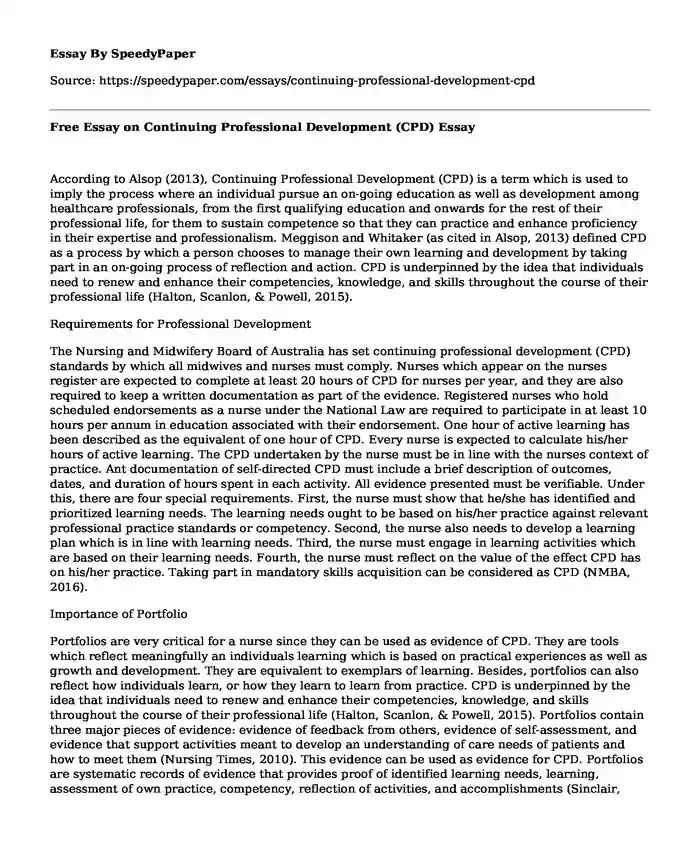
| Type of paper: | Essay |
| Categories: | Health and Social Care Nursing Career Professional development |
| Pages: | 3 |
| Wordcount: | 681 words |
According to Alsop (2013), Continuing Professional Development (CPD) is a term which is used to imply the process where an individual pursue an on-going education as well as development among healthcare professionals, from the first qualifying education and onwards for the rest of their professional life, for them to sustain competence so that they can practice and enhance proficiency in their expertise and professionalism. Meggison and Whitaker (as cited in Alsop, 2013) defined CPD as a process by which a person chooses to manage their own learning and development by taking part in an on-going process of reflection and action. CPD is underpinned by the idea that individuals need to renew and enhance their competencies, knowledge, and skills throughout the course of their professional life (Halton, Scanlon, & Powell, 2015).
Requirements for Professional Development
The Nursing and Midwifery Board of Australia has set continuing professional development (CPD) standards by which all midwives and nurses must comply. Nurses which appear on the nurses register are expected to complete at least 20 hours of CPD for nurses per year, and they are also required to keep a written documentation as part of the evidence. Registered nurses who hold scheduled endorsements as a nurse under the National Law are required to participate in at least 10 hours per annum in education associated with their endorsement. One hour of active learning has been described as the equivalent of one hour of CPD. Every nurse is expected to calculate his/her hours of active learning. The CPD undertaken by the nurse must be in line with the nurses context of practice. Ant documentation of self-directed CPD must include a brief description of outcomes, dates, and duration of hours spent in each activity. All evidence presented must be verifiable. Under this, there are four special requirements. First, the nurse must show that he/she has identified and prioritized learning needs. The learning needs ought to be based on his/her practice against relevant professional practice standards or competency. Second, the nurse also needs to develop a learning plan which is in line with learning needs. Third, the nurse must engage in learning activities which are based on their learning needs. Fourth, the nurse must reflect on the value of the effect CPD has on his/her practice. Taking part in mandatory skills acquisition can be considered as CPD (NMBA, 2016).
Importance of Portfolio
Portfolios are very critical for a nurse since they can be used as evidence of CPD. They are tools which reflect meaningfully an individuals learning which is based on practical experiences as well as growth and development. They are equivalent to exemplars of learning. Besides, portfolios can also reflect how individuals learn, or how they learn to learn from practice. CPD is underpinned by the idea that individuals need to renew and enhance their competencies, knowledge, and skills throughout the course of their professional life (Halton, Scanlon, & Powell, 2015). Portfolios contain three major pieces of evidence: evidence of feedback from others, evidence of self-assessment, and evidence that support activities meant to develop an understanding of care needs of patients and how to meet them (Nursing Times, 2010). This evidence can be used as evidence for CPD. Portfolios are systematic records of evidence that provides proof of identified learning needs, learning, assessment of own practice, competency, reflection of activities, and accomplishments (Sinclair, Bowen, & Donkin, 2013). Therefore, they can be used as evidence to CPD.
References
Alsop, A. (2013). Continuing Professional Development in Health and Social Care: Strategies for Life Long Learning. Hoboken, NJ: Wiley-Blackwell.
Halton, C., Scanlon, M. & Powell, F. (2015).Continuing Professional Development in Social Work. Bristol, UK: Policy Press.
Nursing and Midwifery Board of Australia (ANMC). (2016). Guidelines for
Continuing Professional Development. Retrieved from: http://www.nursingmidwiferyboard.gov.au/documents/default.aspx?record=WD10%2f135&dbid=AP&chksum=8UL9PD4%2byPR9h99u%2b6alcA%3d%3d
Nursing Times. (2010). How to compile a professional portfolio of practice 2: structure and building evidence. Retrieved from: http://www.nursingtimes.net/roles/nurse-managers/how-to-compile-a-professional-portfolio-of-practice-2-structure-and-building-evidence/5020802.fullarticle
Sinclair, P. M., Bowen, L., & Donkin, B. (2013). Professional nephrology nursing portfolios: Maintaining competence to practice. Renal Society of Australasia Journal, 9(1), 35-40.
Cite this page
Free Essay on Continuing Professional Development (CPD). (2019, Sep 13). Retrieved from https://speedypaper.com/essays/continuing-professional-development-cpd
Request Removal
If you are the original author of this essay and no longer wish to have it published on the SpeedyPaper website, please click below to request its removal:
- Social Inequality Essay Sample
- Essay Example Comprising Requirements for Nurses
- Free Essay Sample on Speech Communities
- Free Essay Sample on Business Advertisements
- Correlations Essay Example
- The Truman Show - Movie Review Example
- Essay Sample on How the Institutions Traumatize the Elderly Population
Popular categories




